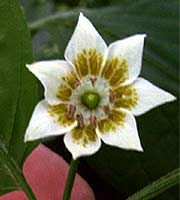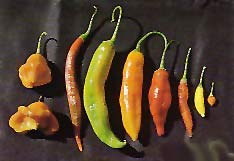By Dave DeWitt
Fiery Foods & BBQ Central Recommendations
Chile Pepper Bedding Plants… over 500 varieties from Cross Country Nurseries, shipping April to early June. Fresh pods ship September and early October. Go here
Chile Pepper Seeds… from all over the world from the Chile Pepper Institute. Go here
The Plant
The baccatum species, familiarly termed “ají” throughout South America, originated either in Bolivia or in Peru and, according to archaeological evidence, was probably domesticated in Peru about 2,500 B.C. Extensive baccatum material found at the Huaca Prieta archaeological site in Peru shows that the species was gradually improved by the pre-Incan civilizations. Fruit size increased and the fruits gradually became non-deciduous and stayed on the plants through ripening. There are at least two wild forms (varieties baccatum and microcarpum) and many domesticated forms. The domesticated ajís have a great diversity of pod shape and size, ranging from short, pointed pods borne erect to long, pendant pods resembling the New Mexican varieties. One variety of aj, puca-uchu, grows on a vine-like plant in home gardens. The baccatum species is generally distinguished from the other species by the yellow or tan spots on the corollas, and by the yellow anthers.

‘Kellu-Uchu’ Variety
Baccatums are cultivated in Argentina, Colombia, Ecuador, Peru, Brazil, and Bolivia, and the species has been introduced into Costa Rica, India, and the United States. In the United States, they are grown to a very limited extent in California under the brand name Mild Italian and in Nevada under the brand name Chileno.
Botanical Traits
The species name “baccatum” means berry-like, an allusion to the smaller-podded varieties. The baccatums are tall, sometimes reaching 5 feet, have multiple stems and an erect habit, occasionally tending toward sprawling. The large leaves are dark green, measuring up to 7 inches long and 4 inches wide.

Baccatum Flower Showing Spots on the Corolla
The flower corollas are white with distinctive dark green or brown spots; anthers are yellow or tan. The pods usually begin erect and become pendant as they mature,are elongate in shape, measure between 3 and 6 inches long and ¾ to 1½ inches wide. They usually mature to an orange-red, but yellow and brown colors also appear in some varieties. The pods usually measure between 30,000 and 50,000 Scoville Heat Units.
The baccatum plants tend to stand out in the garden like small trees. Their growing period is up to 120 days or more, and the plants can produce 40 or more pods.
Flavor Profiles
The pods have a distinctive, fruity flavor and are used fresh in ceviche (lime-marinated fish) in South America. They are also used in fresh salsas and the small yellow varieties are prized for their lemony aroma. The pods of all ajís are also dried in the sun and then crushed into colorful powders.
South American food expert Mary Dempsey has noted, “Ají is a banana pepper-shaped pepper called “ají amarillo” when it is yellow or orange and “ají colorado” when red–a distinction that is important only in the hue of the dish being prepared. When dried, it is often referred to as “cuzqueño,” after the city of Cuzco. Piles of the orange, gold, and brilliant red peppers are found in every outdoor market in Peru, tossed in jumbled piles, stacked in pyramids by more enterprising vendors or divided by color upon handwoven cloths.”





